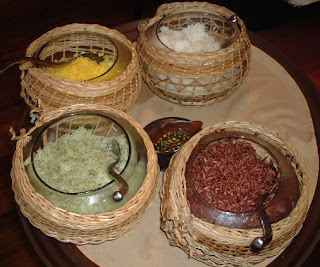
3
.
Turkey day in Bangkok
I was told that the first American Thanksgiving was celebrated in 1621 in the Plymouth Colony to mark a harvest feast. In 1941, Thanksgiving became a national holiday for all Americans on every fourth Thursday of November. Although it has no special meaning to Thai people, but we as expatriates in Bangkok did look for some good deal for this once-a-year Turkey dining. Friends arranged the Thanksgiving dinner served not only turkey but also seafood, since they understand that I am not a bird person.
I went to Novotel Siam Square that night, where my Thanksgiving dinner was arranged in the Square Restaurant of the hotel.
By first glance upon arrival I wondered it was a turkey night or seafood one. There was no time for me to figure it out before more acid melted my stomach. Indeed the seafood selections were tempting.
I started with organic greens and Phuket rock lobster, accompanied by black olive and olive oil dressing. My salad dish was a satisfied one. Followed was the cold appetizer included rock lobster meat in cocktail sauce, crab meat in shell, a portion of blue swimming crab, and half rock lobster with salmon roe, After two courses of cold fare, I was thinking of the turkey which was the star for the night. The 3rd course, however, was a hot appetizer. Still it made sense as hot appetizer followed by the cold one. I had soft shell crab in black pepper and seafood sauce, too hot for me!
Pumpkin soup served after the hot appetizer helped cleaning the taste of unwelcome spiciness of the seafood sauce, and it was rich and aromatic. Soon after I finished the last drop of the soup the main course arrived. I got a generous portion of a turkey drumstick accompanied with a bit of the stuffing and vegetable. The meat was tender and seasoned to satisfy my taste buds.
While I was about to conclude the dinner with the orange sorbet in iced orange, aroma of grilled seafood passed by so I decided to accommodate one more dish. The mixed grill seafood included a piece of red snapper, sea bass, salmon, grouper, and two pieces of tiger prawn. All grilled to perfection. Dessert time was the orange sorbet in iced orange and some tropical fruits.

If I was not really full I would have sampled the fresh oyster from south of Thailand, or done it the tempura way. There were also sirloin steak, roasted duck, roasted ham, seared whole salmon, Japanese sashimi and more .. The selection of the seafood dinner buffet was big.
The square is where Novotel Bangkok offer quality seafood buffet for food lovers. Cost is THB (Thai baht) 930 net per adult.
The Square ***
Novotel Bangkok on Siam Square
392/44 Siam Square Soi 6
Rama I Road
Pathumwan,, Bangkok 10330
Tel.: 02.209.8888
Square
Open daily: 6:30 am - 10:30 pm
Pay (buffet dinner for two): around THB 1,800
